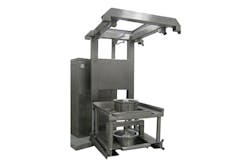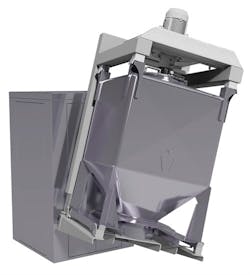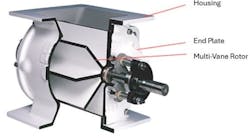One of the most significant functions and consequently one of the most important aspects in a powder processing system is blending. In most food applications, it is the major source of increasing the value of the products that go into the process. This is the case in manufacturing sports nutrition products to bakery items to everything in between.
An increasing challenge in the powder handling industry is how to accommodate a wide portfolio of recipes and vast array of different ingredients, several of which pose an allergen risk. Some companies have been willing to spend significant amounts of capital installing the highest-speed mixers and packing lines to achieve high efficiency and throughput. But just because a mixer is high speed, does not necessarily mean that it provides the best process solution.
Whether a beginner or seasoned professional, choosing a mixer from the extensive options available can be confusing and overwhelming. This article poses some questions to consider during the blender selection process.
Batch or continuous manufacture?
Before selection, the most important decision is whether to batch or continuously manufacture. Does the process require swapping recipes on a regular basis or will the same product be produced day in, day out? If there are no changes to be made, then it makes sense to consider continuous processing with large, fixed mixers that are coupled to the upstream and downstream processes. However, many manufacturers are finding that consumers’ desire for more variety results in more recipes being added to the ever-expanding product portfolio. The consequence of which is more recipe changes than ever before. This leads to the need for a close examination of how mixing will be conducted. In this case, batch processing is the only way.
When selecting a blender for powder mixing plants, consider these eight points, which refer mainly to the case for batch processing given this is an expanding area of consideration.
1. Powder characteristics
A free-flowing powder with similar ingredient particle sizes will mix easily. A gentler blending approach will work well here, such as tumble blending or ribbon blending.
On the other hand, for cohesive, sticky powders to mix homogeneously, work needs to be applied to the material, forcing the particles to fold and join. In this case, blenders that offer high shear in the form of knives or intensifiers are required. Applying the right amount of shear is vital to intermesh and blend the particles, however, if mismanaged, particle degradation and heat buildup may occur.
2. Batch size
Big is not necessarily better for blenders. The blender might be large enough to match the order amount and batch size, but pay attention to loading times. Consider how long it will take to fill by ripping and tipping 25-kilogram sacks of ingredients. Then think about how long it will take to empty the product to packing. During this time the mixer will stand idle and be unproductive, which is not efficient. Companies often do not realize the cost of this lost time in filling and emptying the mixer, but it should be considered for the waste that it represents.
Also, consider if there are different batch size demands. Do customers always want the same size orders? Will there be a need to make small-sized batches of half or a quarter of the large batches? If there is wide variability consider using intermediate bulk container systems (IBCs) for blending, whereby different-sized containers can be accommodated on one blender.
3. Mixing time
Do not be fooled by claims of only a four-minute blend time. It is important to weigh up the full end-to-end process stage of blending, from filling the mixer to emptying it and getting it ready to go back into operation. It may only take four minutes to blend, but it could take two hours to load and three hours for packing to call off – for a total blending time of five hours and four minutes.
In-bin/IBC blending might take a little longer for the blend cycle (often 10 to 15 minutes), but can save time as formulation of the recipe is done offline and the container is removed immediately from the blender and taken off to packing. The filling, mixing and packing process steps take place simultaneously. The blender itself does not need cleaning so it is free to go back into service immediately. The only limiting factor is how quickly operators can install and remove the bins from the blender.
4. Changeover time
If several recipe changes are being made throughout the day, using a fixed mixer can be inflexible. A clean-down will need to be conducted each time, thereby increasing the full end-to-end blending time even further.
In-bin blending, on the other hand, offers immediate changeover because there is no cleaning of the blender, which enables up to four batches per hour to be completed.
5. Ease of cleaning
It is important to ensure that the expensive, value-adding ingredients are not “lost” during the mixing process. Consider what might be getting left behind in the blender. All fixed mixers will have some residue left behind at the base of the mixer bowl or clinging to the sidewalls, shaft, paddles and bearings; this product is then washed away during cleaning. This is valuable product that costs money and should not be flushed down the drain.
Consider what “hold up” areas there might be in the mixer of choice. Can operators safely and easily access all the corners and joints? Are the paddles/shafts removable? Are there easy-access doors? What safety locking systems are incorporated?
On a fixed mixer, clean-down time between recipes can vary from as little as half an hour for a dry clean between non-allergen recipes, up to a full eight-hour shift for a full, wet clean and dry. This represents a significant amount of not only waste, but also manpower costs since this is usually a labor-intensive activity.
With in-bin blending, only the container is cleaned, which is conducted offline. Even if the IBC has a complicated split butterfly valve, which needs to be removed for cleaning, this will not affect the overall equipment effectiveness rate of the blender as other previously cleaned IBCs will be returned to the manufacturing process to maintain the optimum flow.
6. Risk of cross-contamination
With increasingly more products containing allergens, it can be challenging to manage changeovers and clean-downs. Particularly tricky are the fixed mixers and inline conveying systems because these systems are coupled, so it can take a long time to clean down between recipes and to ensure cleanliness.
If different recipes are to be mixed on the same mixer, then consider the risk of cross-contamination if cleaning is not done properly. To mitigate the risk, some companies dedicate a blender to allergen recipes. This is acceptable if only one additional fixed mixer is needed, but may not be practical for more than one.
For allergen handling, in-bin blending offers a simple, safe solution. Containers can be used one time for allergens then cleaned and used next time for a non-allergen product. A common blender can be used as there are no product contact points on the blender.
7. After mixing segregation risk
Even though the fixed mixer may be providing well-blended material, this does not guarantee production of a quality product as it needs to be transferred out of the mixer. This is when segregation of the mix might occur as air displaced by powder leaving the mixer carries the “fines” back up through the powder. This is further exacerbated if large product transfer heights are involved. In this case, the particles have more chance to move apart and de-mix the blend as some will move faster than others depending on their particle density and characteristics.
Consider the ease of discharge from the fixed mixer. Ensure the mixer empties fully with no residual product held up. Consider the opening size of the discharge point because some powders might be sticky and will have poor flow properties and are likely to become stuck. Then again, the free-flowing products could suffer from a core flow through these discharge points, which will cause segregation.
IBCs help to reduce the issue of segregation. Not only is the product mixed within the container, but it is also then transported to feed to packing where it is coupled to the infeed hopper, reducing the drop height. A note of caution, not all IBCs are equal. Those with butterfly valves can still have product segregation issues due to core flow and rolling of particles. Where this is a high risk, it is worth using cone valve IBCs, which offer the best protection against segregation due to product flowing under mass-flow discharge with all particles moving down through the bin in unison.
8. Factory space
Beyond mixer size, consider what space is needed around the mixer for loading and unloading product and cleaning. Also, check on what ceiling height is necessary for access above and below.
IBC blenders tend to have a small footprint and head height, so if space is an issue, then it is worth exploring these further. IBC blenders can be located in open areas with low hygiene control since they provide a closed process.
Proper blender selection comes with these added benefits:
Increased capacity
- By reducing the downtime of the mixer for non-value add functions, greater efficiency can be obtained and production capacity increased
- Quick product changeovers because of no cleaning of the IBC blender provides increased production capacity
- Multiple batch sizes can be mixed in one IBC blender, therefore, eliminating the need for multiple mixers
Cost savings
- By reducing the amount of idle time wastage
- Incorporating more efficiency in the blending process can reduce the number of shifts required
- Lower manpower costs for cleaning
- Minimized lost product via residue or scrap due to it becoming de-mixed
- Eliminating inventory or work in progress
Improved product quality
- Prevent segregation for a better final product that is of high quality every time
- Removal of the risk of cross-contamination
- Closed hygienic system
Don’t be swayed by choosing the cheapest option just to get started or using “what everyone else has” (they may not have done research as well as you have). Think differently and see where it may take you.
Dan Ruble is the vice president of Matcon Americas, leading Matcons’ business efforts in North, Central and South America. Being at the forefront of the materials handling and powder processing industry for nearly 25 years, Ruble’s wealth of experience has been instrumental to Matcon installing many major projects in the region with both local and major global companies.




